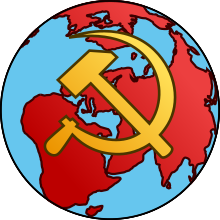
Bolshevization of the Communist International has at least two meanings. First it meant to change the way of working of new communist parties, such as that in the UK in the early 1920s.[1] Secondly was the process from 1924 by which the pluralistic Communist International (Comintern) and its constituent communist parties were increasingly subject to pressure by the Kremlin in Moscow. The autonomy of national communist parties was downplayed and the Comintern became a tool of Soviet foreign policy. [2][3]
Prior to 1924 Bolshevization included that parties affiliated to the Communist International were based on the principles of democratic centralism. This means that political decisions reached by voting in national parties were binding upon all members and that all democratic decisions of the Communist International, and of its elected Executive Committee, were binding on member parties.[1]
Bolshevization also included a transformation of the organisation of, for example, the British Communist Party from 1922. Early parties that had merged to form it had more informal control by individuals, rather than a democratic centralist structure. The party also wanted to ensure that it would not be one where “as a rule very few members do the work while others are inactive and apathetic” but rather one where “every member would have to be a working member”.[1]
During the Fifth Congress of the Comintern in 1924 "A new policy of "Bolshevization" was adopted, which dragooned the Communist Parties toward stricter bureaucratic centralism. This flattened out the earlier diversity of radicalisms, welding them into a single approved model of Communist organization. ...Respect for Bolshevik achievements and defense of the Russian Revolution now transmuted into dependency on Moscow and belief in Soviet infallibility. Depressing cycles of "internal rectification" began, disgracing and expelling successive leaderships, so that by the later 1920s many founding Communists had gone. This process of coordination, in a hard-faced drive for uniformity, was finalized at the next Congress of the Third International in 1928.[2]
Over time, along with the development of Stalinism in the Communist Party of the Soviet Union, this 1924 style so called "Bolshevization" became more clearly Stalinization. One view on this process can be seen by utilizing “insights from Sovietologists to argue that Stalinism constituted a politics and practice connected with but distinct from Bolshevism. Reviewing Comintern and party history, it proposes a specific periodization. State Bolshevism, 1919–1923, saw subjugation of the American and British parties to Russian imperatives. Incipient Stalinism, 1924–1928, witnessed restructuring of the politics of subordination. From 1929, Stalinization accomplished a distinctive subordination."[4]
The Sixth Congress of the Communist International in 1928 took a radical turn as the Comintern decided that capitalism was reaching its final stages. There was less support for wars of national liberation in colonial regions, especially after the collapse of the Comintern in China.[5]
In the Italian Communist Party, Antonio Gramsci took the lead in promoting Bolshevization.[6] In Prague, it was Klement Gottwald who came to power in the Communist Party of Czechoslovakia by taking charge of Bolshevization.[7]
In Spain, there were major efforts that culminated in the Spanish Civil War after 1935.[8]
A number of senior KPD (German Communist Party) leaders, in exile in the Soviet Union, were caught up in Joseph Stalin's Great Purge of 1937–1938 and executed.[9]
- ^ a b c Pelling, Henry (1958). "THE BRITISH COMMUNIST PARTY - A HISTORICAL PROFILE". Internet Archive. pp. 18 to 23.
- ^ a b Eley, Geoff (2002-04-11). Forging Democracy. Oxford University PressNew York, NY. doi:10.1093/oso/9780195037845.001.0001. ISBN 978-0-19-503784-5.
- ^ Valentine Lomellini, ed. The rise of Bolshevism and its impact on the interwar international order (Springer Nature, 2020).
- ^ McIlroy, John; Campbell, Alan (2019-05-04). "Bolshevism, Stalinism and the Comintern: a historical controversy revisited". Labor History. 60 (3): 165–192. doi:10.1080/0023656X.2019.1572872. ISSN 0023-656X.
- ^ Gupta, Sobhanlal Datta (2017). "Communism and the Crisis of the Colonial System". In Pons, Silvio [in Italian]; Smith, Stephen A. (eds.). The Cambridge History of Communism. Vol. 1. pp. 220–231. doi:10.1017/9781316137024. ISBN 9781316137024.
- ^ Bates, Thomas R. (1976). "Antonio Gramsci and the Bolshevization of the PCI" (PDF). Journal of Contemporary History. 11 (2): 115–131. doi:10.1177/002200947601100207. S2CID 153795445.
- ^ Skilling, H. Gordon (1961). "Gottwald and the Bolshevization of the Communist Party of Czechoslovakia (1929-1939)". American Slavic and East European Review. 20 (4): 641–655. doi:10.2307/3004097. JSTOR 3004097.
- ^ Tim Rees, "Deviation and discipline: anti-Trotskyism, Bolshevization and the Spanish Communist party, 1924–34." Historical Research 82.215 (2009): 131-156.
- ^ McNeal, Robert H.; Conquest, Robert (1969). "The Great Terror: Stalin's Purge of the Thirties". International Journal. 24 (4): 838. doi:10.2307/40200310. ISSN 0020-7020. JSTOR 40200310.
